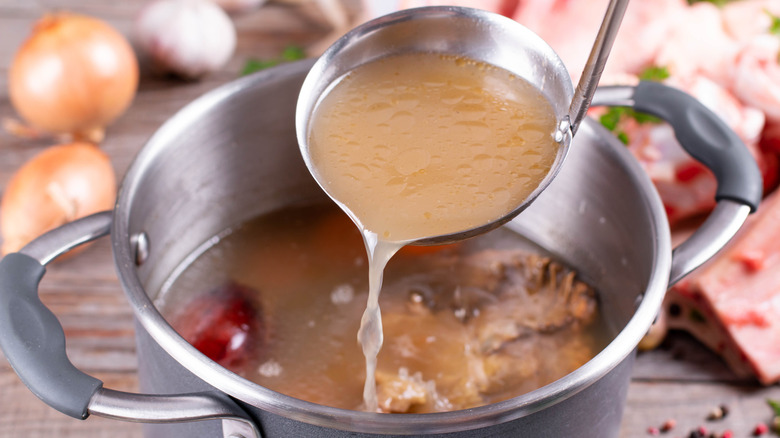The Biggest Mistake You're Making While Cooling Stock Pots
You just spent hours tending to a stock (or letting your slow cooker tend to it, or even letting your pressure cooker speed up the process). The last thing you want to do is let it languish on the counter, cooling slowly as a giant thermal heat sink, breeding bacteria. According to the FDA, food must be cooled to under 40 degrees Fahrenheit in under two hours. However, didn't you hear that you shouldn't put hot food in the refrigerator?
It seems like the trolley problem of the kitchen, but it doesn't have to be. You'll hear that the myth of not putting hot food in the fridge has been busted, but that's not the whole story. If you're Googling "Should I put my hot stock/soup straight into the fridge," we don't have time to waste: The quickest, safest way to handle a giant hot pot of something like stock is to set up an ice bath.
How to set up an ice bath for stock
There are two ways to set up an ice bath for stock: First, take stock (we're not sorry) of your kitchen. Do you have a clean, empty sink or an adequate number of non-glass storage containers? If your sink is clear, you can stop it up, fill it with cold water, add ice, and carefully lower the stock pot into the sink.
You'll want to strain all solids out first, as they add mass that you don't need to fight while you're cooling the stock. It's also important to account for volume displacement in your sink — crying over onions is nothing compared to getting sink water into your carefully tended stock because the water rose over the pot's rim.
If the sink is full of dishes, fret not. Grab a large bowl and fill it partway with ice water. Grab a smaller bowl to nest inside of the bigger bowl and carefully pour or ladle some stock into the inner bowl. Whisk the stock until cool to the touch, and transfer it to a food-safe container to put in the fridge. Repeat until all the stock is cool and put away.
As a general note of caution: untempered or defective glass will crack and/or shatter when exposed to a massive temperature shift, like putting hot stock into an ice-cold bowl. Be careful when selecting containers to carry out the ice bath.
Myth not totally busted
Speaking of food safety standards, food pathogens grow most quickly in the temperature range between 40 and 140 degrees Fahrenheit. The average refrigerator sits at 35 to 38 degrees Fahrenheit. Popping a large, hot pot into your refrigerator can raise the temp into the danger zone, and keep it there — especially if your fridge is on the older side.
Modern refrigerators are generally better at fighting this temperature change, but it can still take too long to cool the stock in the fridge. According to a study published in the Journal of the American Dietetic Association, it can take two to three times longer to cool a soup that is not being agitated (stirred) than one that is.
Leaving the pot in the fridge might not cause everything in it to go bad, but it could still take more than two hours to cool your stock, and reduce the overall temperature. If you're opening the fridge to stir your stock, you're definitely not maintaining a food-safe temperature, either. Food kept in the danger zone for two hours should be thrown out.
In regards to your energy bill (and the environment), putting large quantities of hot food into your fridge also causes the compressor to work hard, so doing this regularly will noticeably increase your energy consumption as well. It's better to rapidly cool your stock in an ice bath — just imagine it's practicing the Wim Hof Method, and it's trendy.


